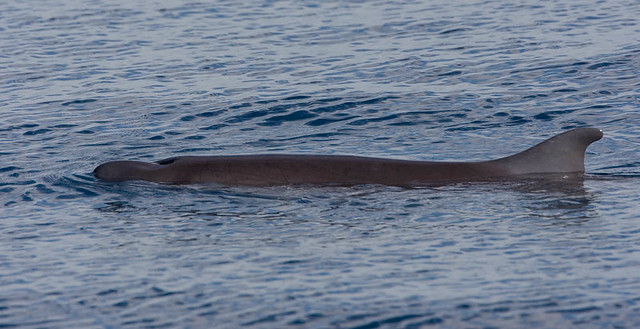Kogia sima Cladus: Eukaryota Name Kogia sima (Owen, 1866) Synonyms * Physeter simus Owen, 1866
* Kogia sima on Mammal Species of the World.
The Dwarf Sperm Whale (Kogia sima) is one of three species in the sperm whale family. They are not often sighted at sea. As such, most information is a result of the study of stranded carcasses. Taxonomy Today, the dwarf sperm whale is generally classified as one of two species, along with the Pygmy Sperm Whale, in the Kogiidae family and Kogia genus, however it was not until 1966 that the two species were regarded as separate, and even more recently that Kogiidae was regarded as a subfamily (Kogiinae) of Physeteridae. Physical description The Dwarf Sperm Whale is the smallest species commonly known as a whale. It grows up to 2.7 m (8.9 ft) in length and 250 kilograms (550 lb) in weight— making it smaller than the bigger dolphins. The species makes slow, deliberate movements with little splash or blow and usually lies motionless when at the sea's surface. Consequently it can be observed only in very calm seas. The Dwarf Sperm Whale is similar in appearance and behavior to its cousin the Pygmy Sperm Whale. Identification may be close to impossible at sea – however, the Dwarf is slightly smaller and has a larger dorsal fin. The body is mainly bluish gray with a lighter underside with slightly yellow vein-like streaks possibly visible. There is a white false gill behind each eye. The flippers are very short and broad. The top of the snout overhangs the lower jaw, which is small. Dwarfs have long, curved and sharp teeth (0–6 in the upper jaw, between 14 and 26 in the lower). These teeth led to the species being described as the "rat porpoise" in the Lower Antilles. Like other Sperm Whales, the Dwarf Sperm Whale has a spermaceti organ in its forehead. Like the pygmy, the dwarf is able to expel a dark reddish substance when frightened or attacked—possibly to put off any predators. Dwarf sperm whales are usually solitary but have occasionally been seen in small groups. They feed mainly on squid and crab. The Dwarf Sperm Whale prefers deep water, but is more coastal than the pygmy sperm. Its favorite habitat appears to be just off the continental shelf. In the Atlantic, strandings have been observed in Virginia, United States in the west and Spain in the east, and as far south as southern Brazil and the tip of Africa. In the Indian Ocean, specimens have been found on the south coast of Australia and on many places along the Indian Ocean's northern coast - from South Africa right round to Indonesia. In the Pacific, the known range includes the Japanese coast and British Columbia. No global population estimates have been made. One survey estimated a population of about 11,000 in the eastern Pacific. Human interaction The Dwarf Sperm Whale was actively hunted by commercial whalers. Occasional harpoon kills are still made by Indonesian and Japanese fishermen. Since the dwarf is more coastal than the pygmy, it may be more vulnerable to human activities such as fishing and pollution. Insufficient data exists as to whether such activities threaten the species survival. ^ Mead, James G.; Brownell, Robert L., Jr. (16 November 2005). "Order Cetacea (pp. 723-743)". In Wilson, Don E., and Reeder, DeeAnn M., eds. Mammal Species of the World: A Taxonomic and Geographic Reference (3rd ed.). Baltimore: Johns Hopkins University Press, 2 vols. (2142 pp.). ISBN 978-0-8018-8221-0. OCLC 62265494.
Pygmy and Dwarf Sperm Whales by Donald F. McAlpine in Encyclopedia of Marine Mammals (2002), San Diego: Academic Press, pp. 1007–1009, ISBN 0-12-551340-2
Source: Wikipedia, Wikispecies: All text is available under the terms of the GNU Free Documentation License |
|


